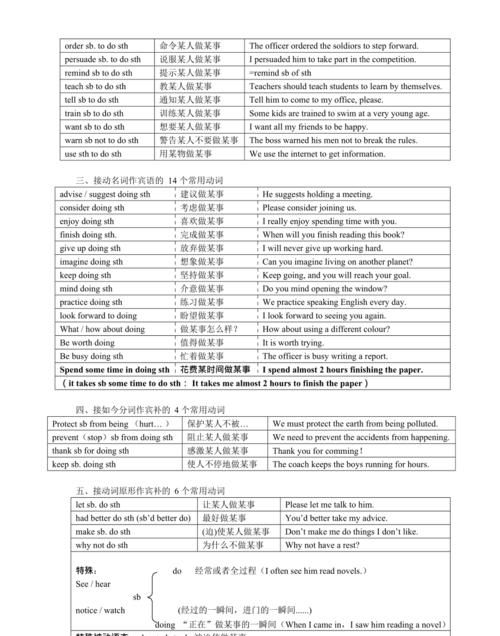本文目录
非限定性动词和限定性动词的区别
一、非限定动词的基本概念
1.非限定动词的种类、意义和特征
非限定动词有三种:不定式(to Do或do)、动名词(doing)和分词(现在分词doing和过去分词done).
1)非限定动词与限定动词(谓语动词)的基本区别限定动词在句中可以单独作谓语动词,其形式要与句子的主语的人称和数取得一致.而非限定动词在句中不能单独作谓语,不受主语的人称和数的限制.
①He likes to sing.他喜欢唱歌.
②They like to sing.他们喜欢唱歌.
(限定动词like受主语人称和数的限制,第一句为likes,第二句为like.非限定动词to sing则不受这种限制,它的形式不随主语而改变.)
③The man walking in front was carrying a red flag.
在前面的人打着一面红旗.
④The men walking in front were carrying red flags.
在前面的人们打着红旗.
(限定词be受主语的人称和数的限制,它的形式须与主语一致.第一句为was,第二句为were.非限定动词walking则不受主语的限制,它的形式不随主语而改变.)
2)非限定动词短语及其复合结构
非限定动词属于动词的一种形式,因此还保留着动词的某些特征:及物动词要有宾语,连系动词要有表语,可以有状语来修饰,而且有时态和语态的变化.
①He promised to Do it tonight.他答应今天晚上做.
(非谓语动词to Do 的动词性质表现在它有宾语it和状语tonisht.)
② I am sorry to have Disturbed you.我打扰了你,对不起.
(to have Disturbed是动词不定式 to Disturb的完成式,说明非限定动词有时态上的变化.)
③I saw a girl Drawing a picture in the house.我看见一个女孩在那所房子里画画.
非限定动词drawing是现在分词,它有宾语picture和状语 in the house.)
④There is no time to Be lost.必须抓紧时间.
(to Be lost 是动词不定式 to lose的被动语态,说明非谓语动词有语态上的变化.)
3)带有宾语、表语或状语的非限定动词称非限定动词短语:即不定式短语、动名词短语和分词短语.如上述例子中的to Do it,drawing a picture;而分词短语又分现在分词短语和过去分词短语.
4)带有逻辑主语的非限定动词(短语)称为非限定动词复合结构:即不定式复合结构,动词复合结构和分词复合结构(也叫独立主格).
①Having written his essay,the Boy was allowed togo home.写完文章之后,那个男孩才被允许回家.
② He lay on his Back,his hands crossed under hishead.他脸朝天头枕着手躺着.
③Christmas Day Being a holiday,the shops were allclosed.由于圣诞节是节日,所有的商店都关门了.
2.非限定动词的时态和语态的变化
1)非限定动词的时态和语态变化表
2)非限定动词本身的时态变化并不能表示动作发生的明确时间:过去、现在、将来和过去将来.非限定动词要依靠句中的谓语动词才能表示动作发生的明确时间,所以可以说非限定动词的时态是一种相对的时态.
3)非限定动词的一般式主要用来表示与谓语动词同时发生的动作.不定式一般式还可以表示在谓语动词后将要发生的动作;分词一般式可用来表示谓语动词以后的连续动作.
①They expect to see their mother.他们希望能够见到他们的妈妈.
②The Bell rang announcing the end of the class.铃响了,通知下课了.
③What he said made me surprised.他说的话使我感到很吃惊.
4)非限定动词完成式表示该动作在谓语动词以前已发生或完成.
①I happened to have read the article when he askedme about it.当他问起我关于这篇文章的情况时我碰巧已经读过了.
② Having Done his homework,he went out for aplay.做完他的功课他出去玩了.
5)进行式和完成进行式只用于不定式.进行式主要用来表示在谓语动词的动作发生时该动词的动作正在进行;完成进行式表示一个从过去开始一直进行到说话时刻的动作(且可能将来还要继续进行下去).
Mike happened to Be passing By when they spoke illof him.当他们正在说麦克坏话的时候,他正好走过那里.
6)非限定动词的语态
非限定动词与它逻辑上的主语关系如是主动关系,用主动式;如果是被动关系,用被动式.
① The boy refused to be paid for climbing the talltree.这个男孩拒绝为爬上这棵树而付给他钱.
② Please get your blood being tested in the nextroom.请你到下个房间去验血.
③The novel is not worthy of being translated.这本小说不值得翻译.
7)非限定动词做宾语、状语时的逻辑主语一般就是句子的主语,而做定语时其逻辑主语可能是句子的主语,也可能是它所修饰的名词.
①The last man to leave the sinking ship was the captain.最后一个离开正在下沉轮船的人是船长.
②Have you anything to say for yourself?
你还有为自己辩护的话吗?
3.非限定动词的否定形式
1)不定式的否定是在to之前加not.
Tell him not to shut the window.告诉他不要把窗户关上.
2)动名词和现在分词的否定形式:把not放在它们的前面.
①Not knowing what to do next,we went to ask ourteacher for some advice.由于不知道下一步该干什么,我们去老师那里请教.
②Paul didn't mind not Being invited to the party.保尔不在乎没被邀请去参加晚会.
3)过去分词的否定形式:把not或never放其前面.
You saw the problem not settled in this way.你看到了用这种方法没把这个问题解决.

什么是限定动词组和非限定动词组 RT.
英语动词有限定(finite)和非限定(non-finite)两类.句子中的谓语动词(predicative verb)是限定的;限定动词受人称(person)和数目(number)的限制.此外,还有时态(tense )、语态(voice)和情态(mood)等....

限定动词与非限定动词的区别
英语上根据动词在句法上是否受到主语的限定,英语动词有可以分为限定动词(Finite Forms of Verbs)和非限定动词(Non-Finite Forms of Verbs)。
限定动词又叫谓语动词,在句中充当谓语,在人称和数上必须和主语保持一致,同时还表现出时态、语态和语气的变化。如:
I play basketball.
He plays basketball.
They played basketball yesterday.
The cars are made in China.
非限定动词,又叫非谓语动词,在句中不能单独充当谓语(但可以和情态动词或助动词一起充当谓语),它们不受主语的限定,没有人称和数的变化,具有名词、形容词和副词的特征,在句中可以充当主语、宾语、表语、定语、状语、补足语等。同时非限定动词也保留了动词的部分特征,有时态和语态的变化,也可以有自己的宾语、表语、状语等,构成非限定动词短语,在逻辑意义上也有其动作的执行者或承受者,叫非限定动词的逻辑主语(Logical Subjects)。
英语非限定动词有三种基本形式:不定式(Infinitives)、动名词(gerund)、分词(现在分词ing Participles和过去分词ed Participles)。
1. 不定式
(1) Jean aims to go tomorrow.
(2) I was delighted to meet him.
(3) The clothes are easy to wash
2.动名词
(1)Reading is an art.
(2)Swimming is a good sport in summer.
3. 现在分词
(1)I saw the dog digging holes in the yard.
(2)Hearing the news, they immediately set off for Shanghai.
(3)He walked down the hill, singing softly to himself.
(4)If traveling north, you must change at Leeds.
4. 过去分词
(1)developed country; fallen leaves; lost child
(2) Half of the guests invited to the party were foreigners.
(3)She can’t make herself understood in English参考资料:百度百科

什么是限定动词词组和非限定动词词组
在句子中可以施展其他功能的动词是非限定动词;这些动词具有一般动词的许多特性,但没有“人称”和“数目”的限制。
非限定动词分三种:不定式动词(the infinitive); 分词( the participle); 动名词(the gerund); 分词又分现在分词( the present participle)和过去分词(the past participle)。
例如:
⑤ Tom found the prescribed text hard to read.
⑥ Helen has a smiling face.
⑦ Your written English is good.
⑧ Smoking is harmful to health.
⑤里的是不定式动词;⑥里的是现在分词;⑦里的是过去分词;
⑧里的是动名词。
非限定动词及其短语,语法功能庞大,涉及下列五方面:
一 当主语
不定式动词和动名词都可当句子的主语,取代名词和代名词。例如:
⑨ To swim in a warm day is joyful.
⑩ Swimming makes us hale and hearty.
二 当补足语
可当主语的句子成分也可当补足语。例如:
● A good government's desire is serving the people.
● What is difficult is to hoodwink the public indefinitely.
同样的,现在分词与过去分词也可充当接系动词(the linking verb)的补足语。例如:
● The witness's evidence is quite convincing.
● At long last, John was fully convinced.
三 当宾语
不定式动词和动名词都可充当及物动词的宾语。例如:
● The baby wanted to drink milk.
● Janet suddenly stopped talking.
它们也可以成为介词的宾语,但除了“except, but, about, than”之外,介词的宾语多数是动名词。
例如:
� I am tired of repeating the same point.
� Most of us desired nothing except to succeed.
� Betty did nothing useful but talk(不带”to”)。
� That weak old man is about to die.
四 当名词修饰语
� Don't disturb the sleeping dog.(现在分词)
� Can you remove the damaged machine?(过去分词)
� That is the only thing to do.(不定式动词)
� The sailors came in a fishing boat.(动名词)
五 当动词修饰语
� Walking along the road, he came across a friend.(现在分词短语)
� Extremely frightened, the picnickers fled.(过去分词短语)
� The athlete stopped to take a rest?(不定式动词短语)
� Peter came running.(动名词)

以上就是关于限定动词与非限定动词,非限定性动词和限定性动词的区别的全部内容,以及限定动词与非限定动词 的相关内容,希望能够帮到您。
